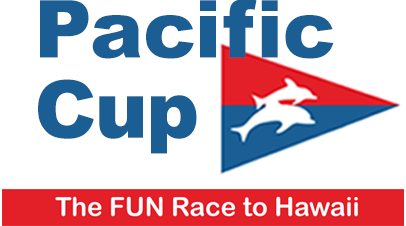2010
Strange Weather, Odd Courses. In a normal race year, skippers and navigators know that a predictable phenomenon called the Pacific High will form at about the time of the race. This offshore zone of high pressure has fine weather with very little breeze at its center. It’s the kind of weather you’d like to vacation in, and sailors whose courses take them too close will find themselves there for a prolonged period. Normally, however, the high is surrounded by clockwise winds that get stronger as you move away from the center. This leads most racers to seek an optimum course sailing in an arc south of the shortest distance to Hawaii, but designed to find strong enough wind to propel their boats at maximum speed.
Not this year. While a high-pressure zone appeared to form near its usual spot, another weather system well to the south shifted the traditional “race” winds well to the north. The few boats who adopted the traditional southerly route soon found themselves running out of “gas” and were forced to head back north just to keep moving. “You lied to us,” mock-complained one racer to the Pacific Cup commodore, who had spent much of the pre-race preparation time expounding on the virtues of a conservative southern course.
As a testament to the impact of weather information and routing software available to sailors, virtually all racers adopted their northerly courses early in the race, to one degree or another. Back on shore, race officials were startled to see, day after day, that the courses taken were all north of the “rhumb line,” a straight line on the map from start to finish, generally viewed as the northernmost sensible course. The final group of starters, the fastest boats in Division E, took the northerly plan to an extreme, in some cases sailing slightly away from Hawaii as they positioned themselves north for their drive to the finish line 2070 miles away.
But Wait, There’s Less. Had the challenge of wind distribution been the only one, it would have been an interesting enough race. However, each group of racers faced an additional challenge: immediately offshore, there was virtually no wind. A 50-100 mile dead zone, of virtually no breeze, trapped the racers, constraining their speeds to a fraction of their normal progress. Some spent several days in this dispiriting weather, losing race time and rocking. The rocking is not only wearing on the crew, but also can cause damage to the boat as sails repeatedly empty and fill causing repeated shock loads to the entire system. This “slatting” was likely responsible for a fair share of damage suffered by several of the boats, leading some to turn back at this early stage with damage or with a view of their schedules that predicted a finish after they could afford.
By a few days in, however, the boats that were continuing had escaped the clutches of the coastal zone and were on their way. Now a new set of challenges arose. The southerly weather system had not only moved the normal winds, it had compressed them. Multi-race veterans called this one of the windiest Pacific Cups they could recall, comparing it to the inaugural race in 1980. Powerful 30-knot breezes alternated with periods of light air to average, in some cases, an ideal 15 knot breeze, but only on paper. “Exhausting” and “terrifying” were terms used by some racers to describe certain passages of the race.
IN THE END, Everybody made it safely to port, either at the finish, or turned back to try another day. At Kaneohe, all were smiling, as ever.
